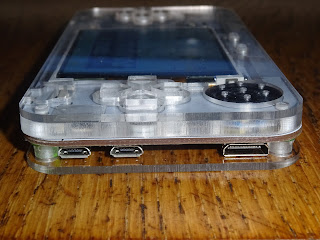This is an old post, preserved for reference.
The products and services mentioned within are no longer available.
Looks very nice when completed, but needs a little assembly first.
The kit unpacks into a PCB, several bags of surface mount parts, the case in the form of four cut sheets of perspex and one sheet of button shapes.
What is no included is a Raspberry Pi Zero W (because you still don't seem to be able to buy more than one at a time), a battery (because postage is tricky) and a microSD card.
Assembly of the PCB was a little tricky due to lots of small surface mount parts, 0603 resistors and caps, and ICs in SOT-23 and SOIC 8 packages.
I think I did well not to lose any of them, although one resistor did go flying and took a while to locate. In the end, I found it because it was 0603. Most of the other parts I have dropped were 1206, so the smaller part stood out.
Also on the front in a single speaker for the audio (most of the circuitry along the bottom is an audio amplifier circuit).
The Pi mounts on the back, not a technique I've seen before, there are surface pads for the 40 pin connector on the Pi, and you just flood solder through the holes so it flows the pad beneath and makes a connection with no height lost for a header connector.
The battery was tricky to find, the build instructions show a 405060 cell (4mm high, 50x60mm), 1800mAh LiPo. I couldn't find one like that, but I did find a 1250mAh 503759 (5mm high, 37x59mm), that was sold as a replacement battery for a GPS. That will do for the moment, I might upgrade if I can find something larger but still no more than 5mm thick.
Always a little scary when you have to cut the battery wires and solder to the board. These LiPo cells don't like their output to be shorted (although this cell does have the protection PCB on the end). The chips on the left hand side of the board form a battery charger circuit, powered from a mini USB socket below. The red and green LEDs on the front indicate charging status. The blue LED is an under-voltage warning.
Next step was getting the case together. The instructions talk about using UV glue to attach the top two laters together, and setting under a UV lamp. I haven't heard of UV glue before, so I cheated and used a couple of pieces of double sided tape instead.
The whole thing is held together with five screws from the back.
These are M3, and the they pass through two of the holes on the Pi, which are M2.5, so they need to be drilled out to 3mm.
This is where I hit a bit of a problem. I couldn't get it to connect to any WiFi networks, not even open ones. Not sure what I was doing wrong? I ended up copying the ROMs directly onto the microSD card and away we go.
I wasn't sure how well the display would respond, being an SPI interface, but it's fine even on a fairly fast game like Sonic.
All in all, a very nicely designed kit, the soldering skills required mean this is not suited to the absolute beginner, but it's good afternoon project with a neat little handheld console to play with once you're finished. Only suggestions would be gluing with parts of the case in advance, as UV glue is not something everyone has. Also, a schematic would be nice.
Update:
Following further testing, it's all working nicely. Battery life seems to be around 5 hours on the 1250mAh LiPo cell I fitted.When the battery is running low, the blue LED comes on (driven by a MAX809T, which is actually a reset chip, but is quite effective here as it's output goes low when the voltage falls below a threshold, which is just what you need for a low battery indicator).
When charging, the red LED comes on.
Charging from a USB 2.0 port took about 2.5 hours, after which the green LED lights.
It's important to use the mini USB jack on the bottom side for charging, and not the micro USB ports on the Pi. These are connected to the cell, so would feed that with too high a voltage. LiPo cells don't like that and tend to get a bit upset about it and swell to twice their size and catch fire.

























